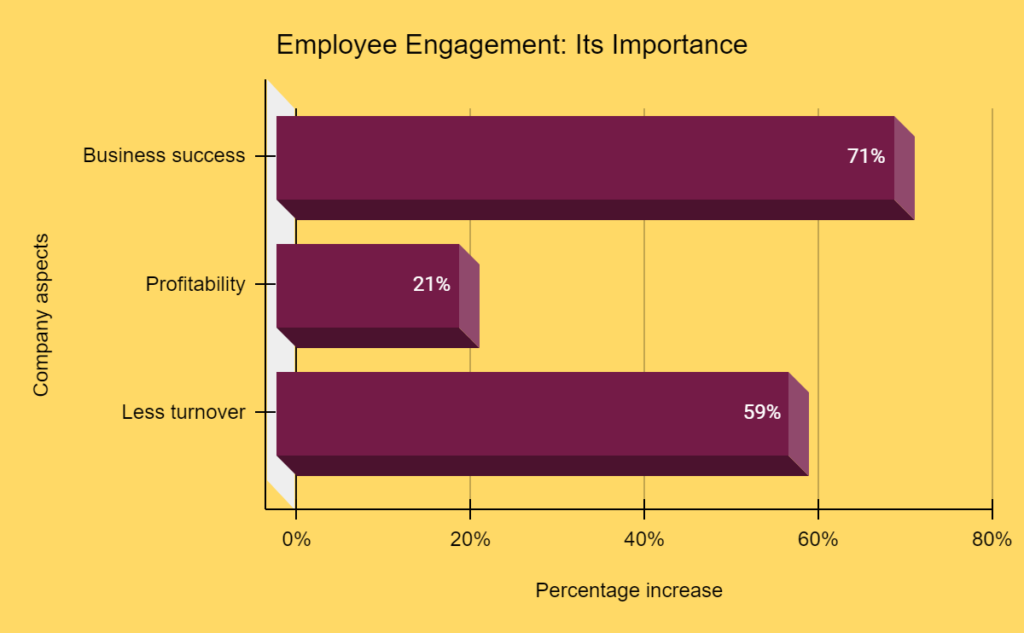How frequently do you see this scenario? A new employee joins your company full of energy, enthusiasm, and new ideas. Their vitality and enthusiasm with which they walked through the door then decrease and ultimately plummet as the days grow into months. True. Employee engagement is a constant issue for many businesses. How can you expect potential clients to be enthusiastic about your firm if your employees are disengaged and uninterested in their work?
Higher absenteeism, lower productivity, higher turnover, more room for human error, safety problems, and other issues can result from disengaged employees.
Don’t be alarmed if this sounds familiar. You’re not on your own. These difficulties and impediments have been faced by many top HR leaders, CEOs, and successful entrepreneurs. However, many of them have discovered strategies to confront this issue full-on.
Today, we have put together a list of suggestions to help you re-energize employee engagement in your company. We even reached out to other HR specialists to get their input on their favorite engagement strategies. One of the essential adjustments you can make for your company’s bottom line is to increase employee engagement. According to a study, firms with engaged employees outperform those with disengaged teams by 202 percent.
So, what factors influence employee engagement? And how can you make sure that your employees stay motivated in the long term? Let’s get started!
Table of Contents
Top 16 Employee Engagement Ideas from the Experts

Employee engagement leads to employees who are more engaged in their employment, will perform their best even when the boss isn’t looking, and are eager to go above and beyond. Engaged people lead to greater corporate outcomes. Several research and polls from renowned institutions back up the good outcomes of high employee engagement.

Now that you have got a glimpse of the importance of employee engagement, let’s check out how you can ensure the same in your firm:
1. Determine the factors that influence employee engagement
Despite what many executives believe, engaging employees requires far more than monetary compensation and employee benefits. The characteristics that foster involvement is also not universal: they vary depending on the organization, generation, and function. So, how can you figure out what drives employee engagement in your company?
Employee engagement has been demonstrated to be driven by a few constants across decades, industries, and demographics, according to research: leadership, learning and development opportunities, and a feeling of meaning at work.
Read More: Employee Engagement and the Role of Workplace Training
Some researchers have identified a hierarchy of engagement: the most fundamental necessities of income and benefits are at the bottom, followed by development possibilities and the prospect of promotion. Next, leadership style is critical: do leaders make employees feel appreciated in their roles? Finally, an alignment of values and meaning is the overriding driver of engagement, which researchers define as “a true sense of connection, a common purpose, and a shared sense of meaning at work.”
There is no clear and fast rule when it comes to what motivates employees. Leadership, development opportunities, and the opportunity to contribute to a meaningful vision, regardless of the size or scope of an organization, are unquestionably important in inspiring employees.
2. Give your employees more than simply a job
It’s easy to lose sight of why we do what we do in the day-to-day grind. However, giving more than a nine-to-five is critical for executives trying to keep their employees motivated. One reality rang loud and clear among the 560 employees polled for Deloitte’s Talent 2020 report: “Engage employees with meaningful work – or watch them walk out the door.”
If the work you’re doing isn’t engaging, it’s impossible to be engaged at work. In fact, 42% of job seekers say their present job does not appropriately use their talents and competencies.
Employers who can figure out what makes work meaningful will find the key to employee engagement. Regardless of their age, gender, location, or length of time with their job, workers say that completing meaningful work would enhance their motivation. This also increases the loyalty quotient.
3. Communicate your company’s vision
Employers who want to give their employees a sense of purpose in their job must have a clear future vision. For job happiness and engagement, this is crucial. The more clearly a leader conveys an inspiring vision to employees, the more likely they desire to participate in it.
HR practitioners can use onboarding tools and eLearning modules to communicate an organization’s vision to workers at scale, ensuring that everyone is on the same page from the start.
4. Instead of measuring input, look at the output
Move away from tracking and evaluating success based on input or hours logged, and instead, focus on outcomes. Is it really that important how many hours your staff spend at work? As long as the work is completed on schedule and to the agreed-upon standard, becoming outcomes-focused emphasizes the final product.
Employees are given more responsibility while being given the freedom to work in a way that fits their lifestyle and personal needs, resulting in increased engagement. In reality, organizations that give employees more flexibility in how they work expand significantly while lowering attrition.
5. Make employee engagement a priority
Have you ever employed someone who appeared alive, interested, and active during their job interview, only to lose their enthusiasm after a few months? Once an individual is settled into their work, initial impressions may give way to a different story.
Rather than employing employees to add engagement to a role, work with them to establish long-term engagement roles. According to Todd Raphael of ERE Media, interaction is a two-way street:
“The best tip I can offer is to say that engagement and passion for a job are a two-way street. Hiring someone you’ve decided is loud or bubbly or outgoing or enthusiastic may provide a sugar high. But if all the things that we all know provide engagement (pay, promotions, recognition, appreciation, interesting work, and so on) aren’t there, the passion is fleeting. Expecting people to be engaged because the employer thinks they are passionate types isn’t a long-term winner.”
6. Ensure that your leaders stick to their promises
It should come as no surprise that senior leadership’s activities have a direct impact on employee engagement. Leaders are critical in establishing meaning for your people because they are the arbiters of change. As a result, team leaders must keep their promises: all input should be followed with actionable, tangible change.
Conduct a 360-degree feedback approach to gain a sounding board for your company’s pain points, then develop a plan to put these adjustments into action. In response to their comments, employees will judge their superiors based on what they do rather than what they say. You’ll need the resources, and once you’ve figured out what makes your staff tick, you can act on these results.
7. Evaluate your present methods
Your current workforce provides valuable insight into the effectiveness of your current talent management strategies. Examine your staff turnover rates closely: retention is a good indicator of whether or not your employees are happy with their jobs. A churn rate of more than 10% indicates a problem with your internal processes. Consider doing an employee engagement survey as soon as possible to determine where you’re going wrong and how to improve your methods.
8. Instead of leave meetings, hold ‘stay’ gatherings
Rather than saying goodbye to disgruntled employees who have decided to go, hold ‘stay’ meetings before saying goodbye. Employees are frequently met with after they’ve announced their decision to depart. Consider McDonald’s, which uses ‘stay’ meetings to eliminate the need for ‘exit’ interviews before it gets this far.
Employers can use a stay meeting to regularly assess an employee’s job happiness and engagement, identifying the challenges and rewards of their position. This can aid in lowering staff turnover rates and addressing personnel issues before they become too serious.
9. Respect employees
Although it may appear simple, recognizing and treating each person with respect is one of the most effective ways for leaders to increase employee engagement. That doesn’t imply constantly showering staff with clichés and praise, but rather making them feel valued and included in your company.
10. Set a good example
Giving employees meaningful work is just as important as creating a setting where they can experience engagement regularly when it comes to engaging them.
It will be difficult for any employee reporting to them to remain interested if the managers in your organization aren’t passionate about their employees or involved in their own roles. Higher-ups should set an example for their staff by bringing the same passion and energy to their jobs.
11. Continue to provide possibilities for growth
After an individual has been trained in their role, their development should continue. To keep employees motivated, they must be regularly challenged and upskilled at work.
This growth does not have to take the form of prescriptive instruction. Allow employees to hone their talents in the ways that they learn best, from attending conferences to meetings and hackathons. The idea is to equip people with the tools and chances for self-directed development rather than strict learning opportunities.
12. Form leadership pipelines
Establishing clear leadership pipelines demonstrates to employees that you care about their development and future with the organization. Employees need to feel like they’re on their way somewhere, which is why succession planning is so important.
If your company lacks established leadership pipelines, you’re not alone: this is a problem that many companies face. Addressing these leadership hurdles has been shown to enhance employee engagement in industry-leading organizations significantly.
13. Follow an effective onboarding program
Starting on the proper foot is critical to whether or not an employee feels interested in their position. In fact, if your first impression is positive, nearly 60% of new employees are more likely to stay with your organization for more than three years. Engage employees before they even walk through the door with onboarding that gets them up to speed.
Employees learn how to do their jobs effectively during onboarding and training, and this is a vital time for them to interact with you, ask questions, and clarify issues. Employees that don’t understand their new tasks will be confused, frustrated, and rushed, which will lead to disengagement.
14. Learning modules might help you get to proficiency faster
One of the most critical things you can take to guarantee that staff is engaged is to train new personnel properly. When you consider that employees who can grasp their new positions are more likely to achieve their objectives and take pleasure in their work, you’ll see that the cost of a thorough onboarding and learning program pays for itself.
Consider including learning modules in your onboarding process that walk new hires through everything they’ll need to know to succeed in their career, such as compliance procedures. You can either use off-the-shelf learning courses or design your own learning modules specifically targeted to your company.
Create personalized learning courses that convey your company’s values and vision to help new hires gain cultural competency faster. This will not only assist new employees in assimilating into your corporate culture more quickly, but it will also help to develop employer brand loyalty from the outset.
15. Make use of technology to give ongoing possibilities for learning
Technology is one of the most effective tools an organization can use to develop and retain personnel. Employees can now take charge of their own learning in various ways, including podcasts, TED speeches, webinars, and online courses. Learning no longer has to take place during seminars or training days.
According to Deloitte’s Human Capital Trends study, learning opportunities are more than just a way to train people for new jobs. According to the report: “Learning opportunities are among the largest drivers of employee engagement and strong workplace culture – they are part of the entire employee value proposition, not merely a way to build skills.
16. Invest in employee training
A professional relationship is similar to any other type of relationship: a little give and a little take. You will establish a community of empowered individuals and reap the advantages when they excitedly put their newfound talents to the test by investing in your employees’ professional development.
Make sure you have the instruments in place to make learning enjoyable and accessible. Consider using current eLearning and development technologies such as microlearning and mobile learning to show your employees that you’re eager to invest in their ongoing education.
Ad: PlayAblo’s Enterprise-Grade Micro-Learning platform is built for the corporate learner. Micro-Learning, along with assessments and gamification features, ensures learning outcome measurement along with sustained engagement.
Find out more and request a custom demo!
Developing thorough training programs is important not only for keeping people interested and involved in their jobs, but it also pays off. In fact, businesses that provide in-depth training programs earn a 24 percent larger profit margin than those not. These businesses have a 218 percent increase in per-employee income. Even while training and development programs have an initial investment, continuing to invest in an employee’s development will yield significant benefits. Because training and development equip employees with the necessary skills to be more productive, they are more productive.
Conclusion: Make No Excuses: Boost Your Employee Engagement!
The capacity to tap into your team’s discretionary effort is the summit of employee engagement, and it needs a true commitment to their professional and personal success. With PlayAblo, you can assist your star performers in thriving. Allow us to demonstrate how we can assist you; request a demo and a callback immediately!
Ad: PlayAblo’s Enterprise-Grade Micro-Learning platform is built for the corporate learner. Micro-Learning, along with assessments and gamification features, ensures learning outcome measurement along with sustained engagement.
Find out more and request a custom demo!







Comments are closed, but trackbacks and pingbacks are open.